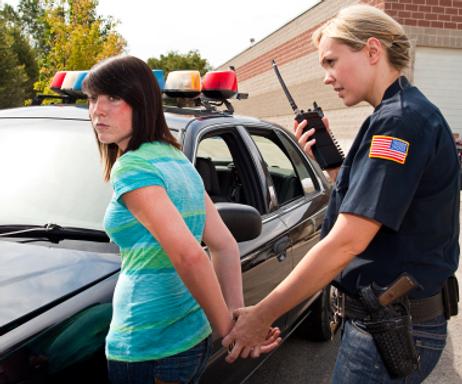Teachers say students are becoming more unruly and disrespectful. Schools complain that it is getting harder to get parents involved. So what is the solution? Some school districts have turned to handcuffing and police intervention as a way to get students under control. However, that idea is not sitting well with many parents and community members – particularly when it is their own children on the receiving end of the harsh disciplinary measures. After all, what type of message does a school send to students when they are throwing handcuffs on young wrists? In this author's opinion, which is supported by research, it is a message that encourages a vicious cycle of future violence and criminality.
This video demonstrates handcuffing.
Recent Incident in Mississippi Results in Policy Change
Jackson Public Schools in Mississippi have had a policy that allows handcuffing students to stationary objects as a means of discipline. The policy has been particularly prevalent at Capital City Alternative School, where teachers and administrators say discipline problems abound. According to a report in the San Francisco Chronicle, a suit was filed last year in response to this policy, which forced the school district to take another look at their disciplinary measures.
The lawsuit was filed by Jeanette Murry on behalf of her son, who was 16 at the time of the incident and a student at the alternative school. Murry stated in her complaint that school staff would cuff students to poles, tables, and other stationery objects – sometimes for hours at a time – for minor infractions like dress code violations. Students would be forced to eat in their shackled position and would have to shout for help when they needed to use the restroom.
In the court settlement, U.S. District Judge Tom Lee ordered the district to stop handcuffing students younger than 13 years of age. The ruling also prohibited the shackling of older students for any infractions other than actual crimes. School employees have now been told by district officials to refrain from using restraints on students.
“We hope with this settlement agreement, the district and school will both take a more positive approach to student discipline,” Vanessa Carroll of the Southern Poverty Law Center told the Chronicle.
More Handcuffing Events Nationwide
The recent Mississippi incident is not the only handcuffing issue to hit the press in recent months. WLOX 13 reported in February that an eleven-year-old student was taken out of a classroom in handcuffs for missing too many days of school. The parents of the student told the station that all of their kids have missed 20 days of school during the current school year, but add that handcuffing a student for a truancy violation – particularly in front of classmates – was disturbing.
In a St. Louis incident last fall, a high school student claims she was put in handcuffs after a dress code violation. The student had worn a Mizzou hoodie to school, which violated a recently implemented rule that all hoodies must match school colors. When the student refused to turn the jacket over to security guards, she was put in handcuffs. St. Louis Public Schools stated at KMOV that the incident was under investigation.
However, one of the most disturbing events of handcuffing involved a six-year-old in Georgia. The kindergartener, Salecia Johnson, was throwing a tantrum in her school that included ripping things off walls and throwing a piece of furniture at school staff. The child was taken to the principal’s office, and her parents were called multiple times, according to a report at WTLC. When the parents could not be reached, the police were called in, and the girl was handcuffed and taken to the police station. Her mother and aunt picked the child up there, in shock at how the six-year-old child was treated.
“Call the police? Is that the first step?” Constance Ruff, Johnson’s mother asked WTLC.
The police told the station that they handcuffed Johnson for her own safety, in accordance with department policy. The officer who was called in said that school property damage was evident and that when he tried to calm the child, she resisted and tried to fight him.
This video reports on a hancuffing incident in a Montgomery County school.
Does Handcuffing Work?
When schools are called out for harsh disciplinary measures like handcuffing, the response is often that some students require the harder means of discipline in order to bring compliance. Schools cite an increase in disrespectful, unruly students that disrupt the education environment for everyone at the school. But does handcuffing bring about the results the schools say they are hoping for?
Not according to much of the research that has been performed today. In fact, evidence suggests that this type of discipline may actually do more harm than good. Massachusetts Citizens for Children states that physical force as a form of discipline rocks a child’s world and breeds a general distrust for adults and authority figures. It may also teach children that the use of force is the best way to settle disputes; in other words, aggression breeds more aggression.
Stop the School to Jailhouse Track states that harsh discipline and an increasing presence of law enforcement in schools is pushing students out of schools and into the criminal justice system. The process disrupts the student’s academic track, which is typically a key component of breaking the cycle of poverty and crime.
Texas State Representative Helen Giddings is currently working on legislation in her state to stop a current practice of writing students tickets for violations. Giddings explained in the Dallas Observer that an increasing number of citations and arrests in Texas schools are leading more students onto a “pathway to prison.” Giddings added that while disrespect and disruptive behavior should not be tolerated in schools, that doesn’t mean children should be criminalized as a result.
There are plenty of methods of discipline available to schools today, from detention to suspension and removal of certain privileges. Why are schools immediately turning to the harshest modes of discipline instead of using constructive, creative ways to teach into the discipline process? It is this author's opinion that these schools can certainly do better and raise their own standards of behavior to encourage students to follow suit.
Questions? Contact us on Facebook. @publicschoolreview















